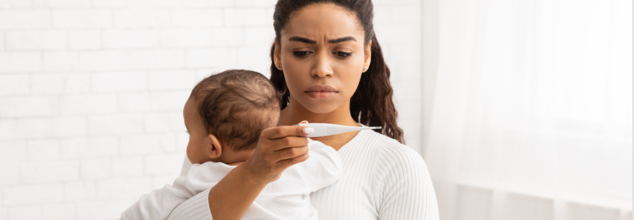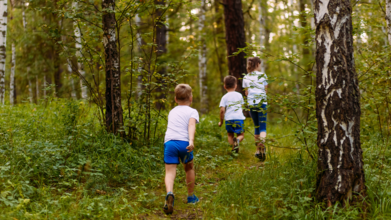- Health Conditions A-Z
- Health & Wellness
- Nutrition
- Fitness
- Health News
- Ayurveda
- Videos
- Medicine A-Z
- Parenting
- Web Stories
Parents Beware! These Signs Could Mean Your Baby Needs A Doctor Immediately

Image Credit: Canva
As new parents, it’s natural to be hyper-aware of every little sound, movement, or behavior your baby exhibits. Babies communicate primarily through crying, body language, and subtle cues, making it challenging to distinguish between normal fussiness and signs of a serious health concern. Understanding when to seek medical attention can be critical in ensuring your child’s well-being. This article will walk you through the most important signs that something is not right with your baby and when to see a healthcare provider.
Parents are usually quick to recognize when something is not right with their child, but distinguishing between minor distress and a serious illness takes attention to important behavioral and physical changes. The most important sign of a baby's health is their normal activity and mood. If your baby is active, feeding properly, and responsive to their environment, they are probably not severely ill. If they seem exceptionally irritable, lethargic, or display physical signs, it is necessary to look into it further.
Fever in Infants
Fever is one of the most frequent but important signs to watch for in newborns. A temperature above 38°C (100.4°F) in an infant under three months is serious and requires immediate medical care. In contrast to older kids, babies might not have other symptoms, so fever is their sole indicator of infection. If your baby has a fever, don't try home treatments—get a doctor's opinion right away.
Is Your Baby Behaving Differently?
Behavioral changes in your baby may reflect an underlying problem. Some red flags are:
Excessive fussing: A baby who cries excessively and can't be comforted might be in pain or discomfort.
Lethargy and reduction in activity: A baby who is too sleepy, hard to rouse, or not interested in the world around them might be ill.
Unusual quietness: If your active baby is unusually inactive or unresponsive, it can be a cause for concern.
While there are normal variations in behavior, persistent changes need to be followed up with a pediatrician.
Low Energy Levels
A listless or sleepy baby might not be alarming at first, but excessive sleepiness can be a sign of a health problem. Indications of concerning fatigue are:
- Sleeping more than usual and being difficult to wake up
- Being lethargic when awake
- Displaying little interest in play or feeding
If your baby is unusually lethargic or unresponsive, a doctor should examine them.
Fussiness
Babies cry for all sorts of reasons -- hunger, discomfort, exhaustion, to name a few. Excessive crying that continues for hours and cannot be comforted may signal:
- Gas or colic
- Ear infections
- Viral or bacterial infections
- Abdominal pain
- General distress
If your baby's fussiness is also accompanied by the trembling, jitteriness, or other atypical physical symptoms, medical consultation is advised.
When to Get Medical Attention?
Trust your instincts—if something feels wrong, don't delay in seeking a doctor. Your baby needs immediate medical attention if:
- Is less than three months and has a fever
- Has a fever that lasts for longer than two days
- Is refusing food and fluids and eating less than half of what they usually eat
- Isn't urinating every six hours
- Looks pale, flushed, or has an unusual color
- Is having trouble breathing
- Has a swollen joint or won't move an arm or leg
It's always best to stick to the side of caution and consult a professional if unsure.
How to Check Your Baby's Temperature?
Getting your baby's temperature correctly is important in deciding if they have a fever. Trustworthy thermometer choices are:
- Digital or mercury thermometers (under the tongue or in the armpit for children over four years of age)
- Digital ear thermometers (for children over three months old)
- Do not use forehead thermometers, plastic tapes, or infrared scans, as they are not accurate.
Taking care of a baby is a huge responsibility, and knowing when to approach a doctor can be the difference in their well-being. If your baby is acting strangely, has a fever that doesn't go away, or shows any other concerning symptoms, see a doctor right away. As a parent, your instincts are strong when unsure, trust them and put your baby first.
To Be A Mother With Multiple Sclerosis: Actor Christina Applegate Gets Candid About Her Diagnosis And How It Changed Motherhood

Credits: Wikimedia Commons
"I miss who I was too," says the Christina Applegate, revealing her emotional conversation with daughter Sadie
She is speaking candidly about how life with multiple sclerosis (MS) has changed not just her, but her relationship with her daughter.
The Dead to Me actress, 53, recently shared an emotional moment from a conversation with her 14-year-old daughter, Sadie, on the Let’s Talk Off Camera with Kelly Ripa podcast. Diagnosed with MS in 2021, Applegate has gradually withdrawn from public life as she navigates the daily physical and emotional toll of the condition.
“I don’t get up in the morning with that,” she said, referring to any sense of personal motivation. “I get up because of her. She’s the reason I’m still here and trying.”
But that strength has been tested in ways that have cut deep—especially as a mother. During their recent conversation, Sadie told her something that Applegate says "was like a knife to the heart."
“She said, ‘I miss who you were before you got sick.’ And I do too,” Applegate said, holding back tears. “I miss that version of me very much.”
The toll of daily life with MS
Applegate has never shied away from speaking about the realities of living with multiple sclerosis.
On Conan O’Brien’s podcast earlier this year, she revealed that she rarely leaves the house anymore. The pain and fatigue have become too overwhelming.
“If people saw what my life was like on the daily, they wouldn’t be able to do it. Because I can sometimes not do it. It’s really, really hard,” she admitted.
And that physical struggle directly impacts her ability to parent. Once an active, involved mom, picking up her daughter from school, dancing with her at home, volunteering in the school library, Applegate now says that version of herself is gone, and her daughter has noticed the change.
“She’s had to see the loss of her mom, in the way that I was a mom with her,” Applegate told PEOPLE in an earlier interview. “She doesn’t see those things anymore. This is a loss for her as well.”
There are days, she added, when the pain is so severe that Sadie simply knows not to ask anything of her. “If she sees that I’m laying on my side, she knows she can’t ask me to do anything. And that breaks me,” Applegate said. “I love doing things for her. I just can’t sometimes. But I try. I try.”
What is multiple sclerosis?
As per the National Institute of Neurological Disorders and Stroke, multiple sclerosis is a chronic, often disabling neurological condition that affects the central nervous system, the brain, spinal cord, and optic nerves. It is an autoimmune disorder, meaning the body’s immune system mistakenly attacks healthy cells, in this case, the protective sheath (myelin) surrounding nerve fibers.
Without intact myelin, nerve signals slow down or get interrupted, leading to a range of symptoms that vary from person to person. These may include muscle weakness, fatigue, numbness, coordination issues, vision changes, and memory problems.
Most people are diagnosed between the ages of 20 and 40, although it can occur earlier or later. MS does not have a cure, but treatments can help manage symptoms and slow disease progression. The severity of symptoms also differs, some people experience mild, manageable relapses, while others gradually face increasing disability.
Life with MS: A new normal
One of the most difficult aspects of MS is its unpredictability. Symptoms can flare up unexpectedly and may disappear for long stretches. While the disease doesn’t typically shorten life expectancy, it does require a major adjustment in daily life.
In Applegate’s case, it has meant redefining her identity, not just as an actress, but as a mother and a person. Still, despite the pain and fatigue, her love for her daughter keeps her grounded and trying.
“Sadie is the reason I’m still here. She gives me the strength to keep going,” Applegate said.
Children’s Brain Development Sees Improvement With More ‘Green Time’ - Study Finds

(Credit-Canva)
A big concern for parents these days is how kids are seemingly swallowed by technology. They no longer plead to go out and play for ‘just five more minutes’. The serotonin and dopamine boost we used to crave while playing outside as kids, does not seem like a big deal any longer. Could this be due to the increase in electronic device usage?
Parents who are worried about their kids screentime are right to be concerned. Many studies have shown the increased screentime slows down brain development. If certain habits can slow down brain development, are there others that can increase brain development?
A new study published in the Environment International journal suggests that living close to green areas, like parks or forests, might lower a child's chance of developing problems like ADHD and autism. This protective effect seems to start even before they are born.
How Green Spaces May Help Before and After Birth
The study found that children were less likely to experience brain development problems if their mothers lived near green spaces before or during pregnancy. The same benefit was seen if the children themselves lived near green spaces when they were infants. These important findings were published in a science journal called Environment International. One of the lead researchers pointed out that having more access to green spaces in cities could truly support healthy brain development in young children and help reduce the number of developmental delays.
Why Green Spaces Might Be Good for Brains
Scientists don't fully understand yet exactly how green spaces might help a baby's brain grow healthily, even while still in the womb. However, they have some ideas. They believe that being around nature can reduce stress and feelings of sadness, encourage people to spend more time with others, and lower exposure to loud noises and very hot or cold temperatures. All of these things could be good for a young child's overall development.
What the Study Discovered
For this research, scientists looked at a lot of information from over 1.8 million mothers and children who were part of the Medicaid program in different states. They used satellite images and the mothers' home addresses to figure out how much green space they lived near. The results were quite interesting:
- Children whose mothers lived near green spaces had a 34% lower risk of intellectual disabilities.
- They also had a 17% lower risk of autism.
- For children who lived near green spaces themselves after they were born, the study found a 19% lower risk of learning disabilities.
The researchers noticed that these protective effects were present at different stages: before pregnancy, during pregnancy, and in early childhood. This suggests that there might be various biological reasons why green spaces are helpful at different times.
Stronger Benefits in City Areas
The study showed that the protective effects of green spaces were even stronger for children living in city areas and for children from Black or Hispanic families. This suggests that green spaces might provide an even greater benefit in places where they are not as common. Increasing access to green spaces in city environments could really support early childhood brain development and help reduce the number of developmental delays.
What We Still Need to Learn
It's important to remember that this study can't prove that living near green spaces directly causes healthier brain development. There could be other factors that also play a role in a child's risk for developmental problems.
Future research will dive deeper into the exact reasons why green spaces might benefit children's brain development. They also want to explore whether different kinds of green spaces—like parks, walking trails, or playing fields—offer different levels of benefit.
Expecting Soon? A New Research Suggests That Your Baby's Sex Is Not Random

Credits: Canva
A baby’s sex at birth might not be the equal coin toss that we’ve always believed it to be. A new study published by the Harvard TH Chan School of Public Health, titled, “Is sex at birth a biological coin toss? Insights from a longitudinal and GWAS analysis” challenges this long-held assumption.
The study was published on July 18 in the journal Science Advances, and it found that several factors, including a mother's age, genetics, and the sex of older siblings—may influence whether she’s more likely to have a boy or a girl.
Patterns Behind the Birth of Boys and Girls: How Was The Study Conducted?
The research looked at more than 146,000 pregnancies involving over 58,000 U.S. nurses from the NIH-funded Nurses’ Health Study, covering the years 1956 to 2015. What they found was eye-opening: families with three or more children were more likely to have either all boys or all girls than if the sex of a child was purely random.
“If you’ve had two or three girls and you’re trying for a boy, your odds aren’t 50-50 anymore,” explained Jorge Chavarro, professor of nutrition and epidemiology and the study’s senior author, in a quote to The Washington Post. “You’re more likely to have another girl.”
Also Read: It Might Not Be Diabetes; It Could Be This Common Pill Causing Heart Disease: Study
The Role of Maternal Age and Genetics
One of the biggest surprises was the link between maternal age and the likelihood of giving birth to all children of the same sex. Women who started having children after age 28 had a slightly higher chance of giving birth to only boys or only girls.
Researchers believe this could be due to biological changes that come with age, such as shifts in hormone levels or physical conditions that may affect which sperm survive and fertilize the egg.
Additionally, the study identified two specific genes that appear to be linked with the likelihood of having children of only one sex. While scientists don’t yet know how these genes affect birth sex, their discovery opens the door for further research.
Chavarro noted that future studies should explore whether lifestyle choices, diet, or even exposure to certain environmental chemicals might also play a role.
Are Families Subconsciously Seeking “Gender Balance”?
The study also touches on social patterns. In families with two children, there was a higher chance of one boy and one girl. Researchers believe this may be because couples tend to stop having children once they have one of each sex, possibly due to a preference for a “balanced” family.
This idea is supported by another paper published in the Journal of Behavioral and Experimental Economics, which jokingly refers to parents who have three boys or three girls as those who “lose the birth lottery.”
When Expectations Don’t Match Reality
The findings also bring up the topic of “gender disappointment”, a real emotional experience for some parents when the sex of their baby isn’t what they hoped for.
A 2023 paper in the BJPsych Bulletin found that in many Western families, this disappointment often stems from a desire to experience raising both sons and daughters.
In everyday life, these expectations can be seen in subtle remarks like “Four boys? Poor you,” or “Still trying for a girl?”, comments that reflect how deeply society views gender roles and balance, reports CBC.
What It Means for Expecting Parents
While the science behind birth sex is clearly more complex than a simple 50-50 chance, experts agree it’s not something to stress over. Rather, it’s a reminder that biology, age, genes, and personal choices all come together in ways we’re only beginning to understand.
© 2024 Bennett, Coleman & Company Limited

